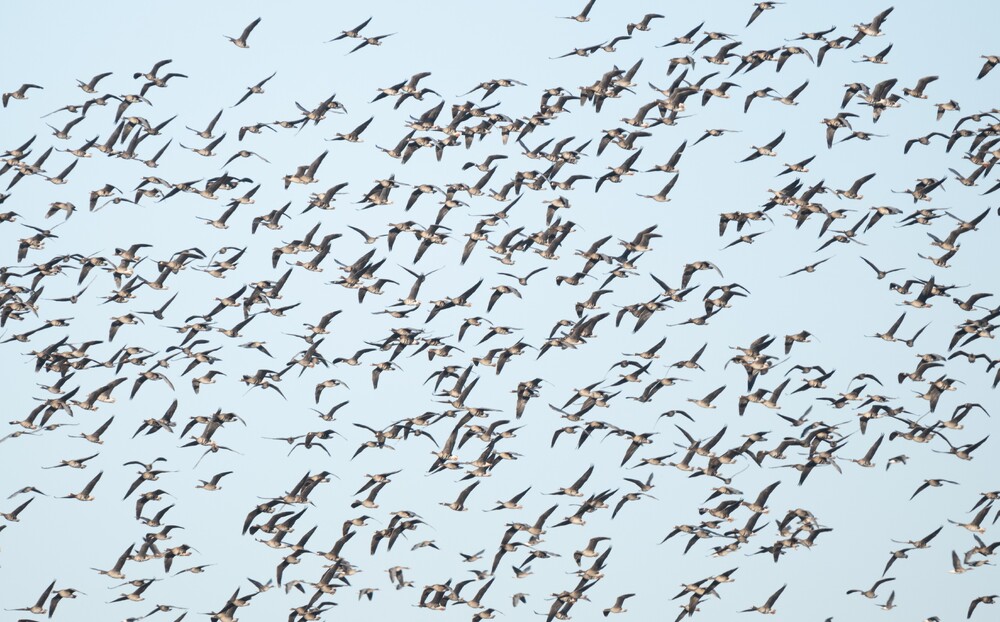site.btaFewer Waterbirds in Bulgaria in 2025 Compared to 2024, 49th Midwinter Census Shows


The 49th wintering waterbird census in Bulgaria (January 16-19) was conducted. Within 4 days, a total of 43 teams of experts and volunteers from the Bulgarian Society for the Protection of Birds (BSPB), the Executive Environment Agency (EEA), Green Balkans, the Regional Inspectorates for Environment and Water (RIEW), the Bulgarian Academy of Sciences, hunting associations and representatives of other NGOs, managed to walk around and collect data on wintering birds in over 300 wetlands in Bulgaria.
Traditionally, the largest number of birds has been recorded along the Black Sea coast and in some large inland dams. There were relatively few birds on the Danube, as the river was at a high level at the time of the census and lacked the so-called sand spits that attracted thousands of birds. Due to the colder weather, most of the small dams and ponds were frozen.
The observed numbers of wintering waterbird species, with aggregated results from over 95% of the reservoirs, are lower compared to last year's census data - 90 species with a total of 249 958 individuals. This compares to 97 species recorded in 2024 with a total of 280,956 individuals. However, the numbers are higher than the 2023 data (88 species with a total of 206,239 ind.) and 2022 (90 species with a total of 206,688 individuals). These numbers are far lower than those found in previous periods. For example, in 1999 and 2000, 404,410 and 652,418 wintering waterbirds were found, respectively.
Several globally threatened bird species were observed during the 49th Midwinter Bird Count in the area of the Burgas lakes, Dr. Petar Yankov from the Bulgarian Society for the Protection of Birds (BSPB) said. Among them are the horned grebe, a small seabird, and two common scoter listed in the world Red Data Book. "These are some of the most endangered species on the planet", the expert said, pointing out that the census found these species nowhere else in Bulgaria.
In 2025 the trend for low numbers of wintering wild geese in Bulgaria remained the same. The teams managed to observe and count a total of 7,562 Greater White-fronted Geese and 66 Greylag Geese, while the globally threatened Red-breasted Goose was not recorded. The record set in 2013, when over 54,000 Red-breasted Geese were recorded in Bulgaria, remains unbeaten.
Again in 2025, the three most abundant waterfowl species observed were the Mallard (40,533 ind.), Common Coot (39,881 ind.) and Great Cormorant (18,853 ind.). Of the globally threatened species, 16,281 Brown-headed Teal, 2 Velvet Teal have been found in the sea off the town of Sozopol, 762 Thorn-backed Grebes in Burgas Lake and Mandra Dam, 5 Eared Grebes on the Southern Black Sea Coast and 5 Mediterranean Storm-Petrels on the Northern and Southern Black Sea Coast. Other interesting sightings include: 3 Mountain Sandpipers at Piasachnik Dam, 1 White-fronted Goose at Ablanitsa Dam, 99 White-eyed Buzzards, 3 Mandarins, 4 Great Water Bulls, 153 Ringed Plovers, 1,453 Mute, 492 Song, 353 Tundra and 3 Black Swans, 1,723 Black-breasted and 3 Red-breasted Mergansers, 3 Grey Cranes at Dragoman Swamp, 33 Sea Eagles, 12 Great Black-headed Gulls in the Burgas area, 1 Great Black-backed Gull at Trastikovo Dam, 22 Great, 223 Medium and 10 Lesser Nuthatches, 881 Dalmatian and 20 Pink Pelicans, 18,479 Lesser and 1,061 Hooded Cormorants, 2,907 Pink Flamingos, 1 Common Eider at Pomorie Lake, 325 Red and 3,237 White-headed Gulls, 3,070 Greater, 9 Red-winged and 2,850 Black-breasted Mergansers, 1,083 Sabine's Gulls, etc. 1 Greater Spotted Eagle was also observed.
In addition, species not typical for the winter months in Bulgaria were observed - 1 White-winged Tern in Durankulak Lake, 2 Little White Herons in Plovdiv, 36 Night Herons, 38 White Spoonbills, 2 White Storks in Southern Bulgaria, 2 Summer Sandpipers at the Arda River, 4 River Sandpipers at the Tseretelovo Dam. Almost all teams used the SmartBirds Pro mobile application for data entry, thanks to which nearly 10,000 records were collected and which helped a lot for the quick summarization of the results.
The Wintering Waterbird Census has been conducted globally since 1967 and is one of the most massive conservation events, involving over 15,000 people. It is conducted simultaneously and synchronized across Europe and North Africa to count waterbirds as accurately as possible. At international level, the information is compiled by Wetlands International. The census provides an assessment of the status of waterbird populations and the condition of their wintering sites, many of which are part of the Natura 2000 ecological network. According to recent data, populations of some globally threatened species such as the Lesser White-fronted Goose and the Brown-headed Grebe continue to decline, putting these species at real risk of extinction.
/VE/
news.modal.header
news.modal.text